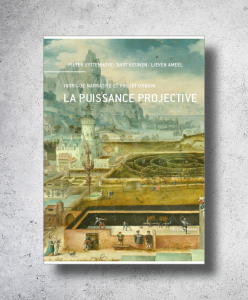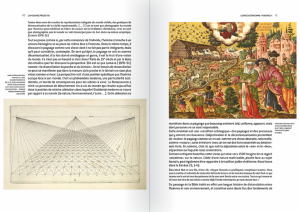For more than two decades, I’ve been working on and off together with scholars of the Ghent Urban Studies Team, and in particular with Bart Keunen, on questions of city literature, narrative urban planning, and the urban humanities. As part of that collaboration, I’ve been involved in collaborating on the volume La Puissance Projective – Intrigue narrative et projet urbain, which has just (5 March 21) been published with the Geneva publisher MétisPresses.

The book examines the narrative properties of urban planning, drawing on a wide range of examples, from post-I-World War Ypres to Disneyland Paris. As can be expected from a book published with an architectural press, the book is beautifully illustrated. Throughout, it connects well-established narrative theories of plot structure and narrative rhetorics with in-depth analysis of particular planning cases. The book brings together, in particular, long-standing work of Pieter Uyttenhove in the field of architecture and planning (architecture, Ghent University), the extensive work of Bart Keunen in the field of chronotopes and urban planning (comparative literature, Ghent University) with some of my more recent thinking on narrative and planning (see, in particular my recent book The Narrative Turn in Urban Planning).
With the collaboration of Johanna Godefroid, Noemi Loeman, Hendrik Sturm, Sofie Verraest & Tom Ysewijn.
Abstract:
“L’imagination narrative, telle qu’envisagée en littérature, joue un rôle tout aussi important dans la conception urbaine et paysagère. Concevoir l’environnement urbain, n’est-ce pas aussi raconter et imaginer un réseau qui réunira en une trame consistante des personnes, des espaces, des objets, des activités, des images éparses?
Depuis les années 1990, le «tournant narratif» nous aide à mieux comprendre les processus créatifs qui accompagnent la conception de projets urbains et de paysage. Par le récit, urbanistes et paysagistes anticipent des situations futures, les organisent en des ensembles cohérents composés d’une multiplicité d’images et de leurs interactions — comme le ferait un écrivain.
Le présent ouvrage, faisant référence à des figures mythologiques comme à des penseurs modernes, jongle entre textes, projets et images, analyses et analogies et approfondit par là ce parallèle littéraire. Différentes disciplines sont conviées: l’anthropologie, la chronophotographie, l’art de la promenade, la philosophie, la sémiologie, la mythologie et l’histoire de l’art. Des ruines du Saillant d’Ypres à Disneyland Paris, de la périphérie romaine à la Défense, cet ouvrage développe des études de cas variées et crée ainsi un terrain fertile pour repenser l’urbanisme et ses enjeux.”
More information here.

